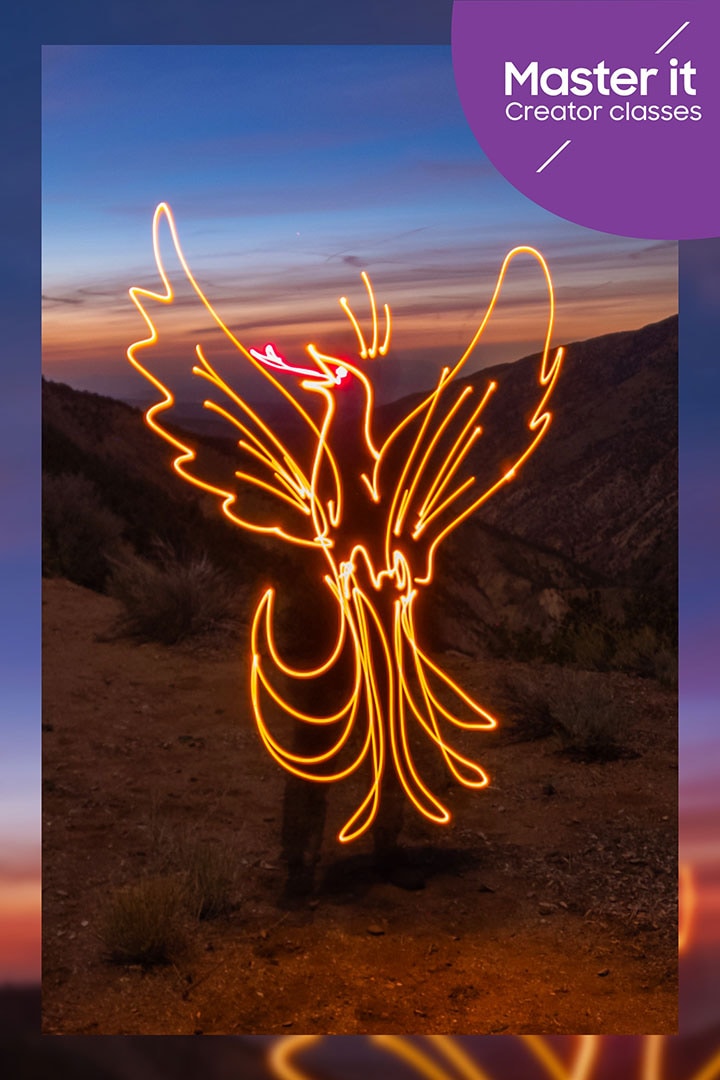PHOTOGRAPHY
Celebrate nature
through light painting
By using long exposures and light trail
photography, you can turn a flashlight
into a paintbrush


The credo of every environmentalist is “leave no trace behind.” That’s why light painting is such a great way to artistically express yourself in nature. Light painting gives you the perfect opportunity to explore the beautiful biomes around you while leaving no greater environmental footprint. You can paint graffiti-like light trails on Mother Earth herself without leaving a permanent mark.
To teach us how to make light paintings, we teamed up with pro light trail photographer Darren Pearson. Inspired by the beaches, forests, plains and deserts of his native California, Darren took advantage of Galaxy S22 Ultra ’s Nightography feature to create light trail photos of animals to represent different elements of nature: a phoenix for fire, an orca for the ocean, a cheetah for wind and an elk for the forest.






Anyone can be a light painter
Light painting is as old as photography. Darren himself was inspired to start light painting after seeing a 1949 photo of Pablo Picasso painting a centaur out of light. "All you need to make a light painting is a camera set up on a tripod in the dark, and then to move a light in front of the lens while the shutter is open," Darren explains. Wear dark clothing while shooting and you'll practically disappear from the final long-exposure shot.
To make a light painting, you need a camera or smartphone that lets you manually change the camera's shutter speed, focus and ISO (or light sensitivity). You can even recycle an old smartphone's flashlight to function as your "paintbrush," although Pearson himself favors multicolored LEDs. "The most important thing is for your light tools to be devices you are comfortable using," he says.


Plan your painting
Because a light painting needs to be done in under 30 seconds, it's critical to simplify your design as much as possible. Practice your strokes so you develop the muscle memory to reproduce it flawlessly when it's time to take the shot. For that step, Darren practiced on the Notes app using his S Pen.
Once a design has been finalized, it’s time to find the proper backdrop. The best environments for light paintings are more remote environments without too much ambient light. The weather is also important to consider. Avoid shooting in inclement weather or windy conditions, since gusts can move your tripod, ruining your shot.
It’s all in the settings
"You can’t have a great photo without a great idea, and likewise, you cannot have a great photograph without the right exposure settings," Darren says. So once you've got your idea, your backdrop and your smartphone on its tripod, it's time to open up the Camera app and switch to Pro Mode.
Depending on how much ambient light is in your environment, Darren recommends manually setting the ISO between 400 and 800 for your first light painting. Now, manually set your focus: Darren says 0.8 is usually a good setting. But the most important setting is shutter speed, which determines how long the shutter stays open. Record how long it takes you to sketch your design, then set the Speed value as close to that number of seconds as possible.


Captured with Galaxy S22 Ultra
The Three C’s
Once you've got the correct settings dialed in, it's time to take your shot. Unless you have an assistant, you'll be in front of the camera when the picture is being taken, so either set the Camera Timer or use your Galaxy S22 Ultra's S Pen to remotely trigger your shot. Then execute your design with your light source pointing towards the camera.
It might take a few tries to get right, but once you get it down, light painting requires very little post-processing to get impressive results. Experiment, Darren says, and remember the three C's: concept, composition and camera settings. You’ll end up with a light painting that’s a work of art.
Start painting with photons
All you need is the right camera and a
bright light.
Galaxy S22 Ultra


Galaxy S21 5G 128GB Certified Re-Newed

















